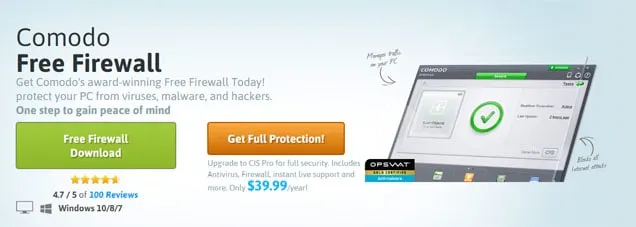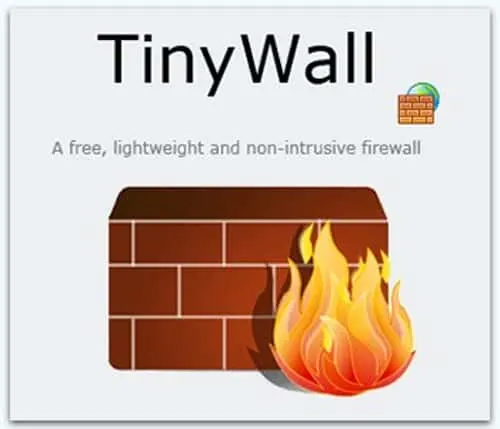Firewalls are so ubiquitous that firewall jargon has been thrown into any action and science fiction movie that involves hackers and computers. They’re so popular (yet not completely understood) that even technologically illiterate folks have at least a vague idea of what they are. And I think just about every Windows user has, at one time or another, had to deal the pains of Windows Firewall.
The only thing more annoying than Windows Firewall is perhaps User Account Control (UAC), though both are crucial security tools that need to stay active unless you really know what you’re doing. At any rate, I personally find Windows Firewall to be an irritating pain in the neck, as do so many other users.
Don’t misunderstand me, however. I think it’s great that Microsoft included a Firewall with its OS – it’s a necessity. I think I would have been even angrier if Microsoft hadn’t included a firewall. Having said that, note that many criticize Windows Firewall for being limited in functionality. So today, we’re going to take a look at the best alternative third-party firewalls for Windows 10.
Before we do, let’s take a moment to discuss the difference between hardware and software firewalls for those of you who don’t yet know the difference.
Software Firewalls vs Hardware Firewalls
I did want to take a moment and point out the difference between hardware and software firewalls. If you’re technologically literate enough to already know the difference, then I recommend jumping ahead to the first best alternative firewall for Windows 10: Comodo Firewall. Otherwise, I’d like to point out that most home users already have a hardware firewall in place, whether they knew it or not.
Every single home router – wireless or not – comes with firmware that’s capable of running a firewall. Usually, the firewalls on your router are rather basic and can’t set advanced policies. Still, it’s better than nothing and provides the first line of defense between your home network and the public Internet.
These types of firewalls are often called hardware firewalls because they ‘live’ on your router, and are tied directly to that networking device.
On the other hand, firewalls like Windows Firewall are software firewalls. These firewalls are loaded into the memory of your computer and carry the same permissions regardless of what network you connect to. On the other hand, hardware firewalls impose the same security policies consistently for a given network.
The firewalls we’ll be looking at today are all software firewalls, but I did want to point out one irksome issue many people run into when trying to let applications through their firewalls.
Acknowledging that you are likely running two firewalls – the software firewall on your computer and the hardware firewall on your router – is crucial to the troubleshooting process. Sometimes you’ll find that a game, office application, cloud service, or other applications aren’t working properly.
Many troubleshooting guides will tell you to first add an exception in your firewall to allow the program through. However, remember that you’ll likely need to configure two firewalls (the one on your PC and the one on your router) to properly allow the application’s traffic through.
Comodo Firewall
I’m a huge fan of Comodo’s security products, and the Comodo Firewall is the best third party firewall for Windows 10. Oh, and guess what? You can download it for free! This firewall is loaded with features. Naturally, you can use it to setup basic policies to block and deny specific ports as you see fit.
But you can also use it to set routing policies. In fact, you can use it to set up policies that act as your own custom kill switch, which will block Internet traffic if your VPN tunnel disconnects.
That way your downloads will only work through the VPN tunnel and your anonymity is protected in the event of a tunnel disconnect.
Plus, the firewall learns which programs you trust, so it won’t inundate you with tons of annoying alerts for applications that are safe. Other key features include the following:
- Game mode that prevents alerts and updates from ruining your gaming experience
- Detailed and personalized alert system
- Application control that allows users to prevent all but specified applications and processes from running
- Cloud-based white-listing
- Many, many other features
If you really want added protection, you can upgrade to the CIS Pro (Comodo Internet Security) for $39.99 (check this listing for the latest live prices) a year. But if all you’re looking for is an improvement over Windows Firewall, then I’d recommend you download the free version of Comodo.
ZoneAlarm
In my personal opinion, ZoneAlarm and the following alternatives pale in comparison to Comodo Firewall. Nevertheless, ZoneAlarm and the remaining options are all third party firewalls that are superior to Windows Firewall. Plus, ZoneAlarm also has a free firewall as well, so if you’re price sensitive, you don’t have to worry.
Not only does it work on Windows 10, but it is also compatible with Windows XP, Vista, 7, and 8.
Of course, the core of this application is a personal firewall that simply permits and denies traffic, but it also monitors programs for strange and suspicious activities to stop threats in their tracks. There’s even a “Full Stealth” mode that makes your computer invisible to attackers and prevents them from scanning or discovering your computer.
Surprisingly, it even comes with identity protection services and 2GB of free online backup space.
Furthermore, it comes with browser security features designed to stop malware, malicious sites, phishing, and dangerous scripts from stealing your browser data. It has anti-phishing features as well as site authentication features to keep you safe online. The ZoneAlarm Free Firewall can (and should) be used with the Free Antivirus package for added protection.
Tinywall
Tinywall, as the name implies, is an incredibly compact and streamlined firewall. In fact, the download size in only one megabyte. And one of the main features that people love so much is the fact that it takes an approach to security that doesn’t include annoying pop-ups. If you’re irritated by Windows Firewall and UAC, then Tinywall will be bliss.
Also, it can block malware threats in real time, such as viruses and Trojans. Blocking and denying applications was designed to be easy, too, so that you don’t have to know which individual TCP/IP ports a particular service uses. Instead, you just need to add the app to the policy.
Other security features include built-in security to prevent firewall tampering by external forces, Hosts file protection, both port level, and domain level block lists, white-lists, IPv6 support, and time-based policies. If it sounds too good to be true, know that this firewall is legitimate.
In fact, I love how clean it is. Similar free software products always try to throw in ads and attach strings. But Tinywall has no strings attached, and doesn’t include ads or offer paid upgrades.
Eset Internet Security
Eset Smart Security is really more of a fully-fledged antivirus and malware protection suite than it is a firewall. However, the package does come with a firewall that’s a vast improvement over Windows firewall. Plus, the security suite comes with a tool that runs diagnostic analysis tests against your home firewall to probe for weaknesses.
This feature can detect weak passwords, out of date firmware, security flaws, and more to help you lock down your first line of defense: the firewall sitting between your home network and the public Internet. And the firewall has all the core features you would expect, such as the ability to set inbound and outbound permit and deny policies.
But the firewall comes with a feature to help hide your computer. It makes your computer invisible by helping it avoid reconnaissance endeavors of network scanners and hackers, which will help prevent attacks on untrusted public networks.
Unfortunately, the firewall doesn’t come with the NOD32 Antivirus package. Instead, it only comes with the premium package. However, the firewall does have some cool features such as host-based intrusion prevention, and the package comes with parental control software too.
AVG
Last but not least is AVG. Like Eset and other antivirus providers, AVG does have a firewall solution as well. I often recommend using AVG to people looking for cheap antivirus protection since AVG offers completely free antivirus and malware protection.
Unfortunately, it doesn’t have a free firewall option (at least not yet), so you’ll have to upgrade to the paid version to gain access to this improvement over Windows Firewall.
To be completely honest, the AVG firewall has an incredibly basic interface, which is one reason why it’s last on the list. But it does have some advantages. First off, it isn’t nearly as intrusive or obnoxious as Windows Firewall. And it seems to have been designed to be as simple as possible.
The interface lacks tons of advanced configuration options unless you use expert mode. You don’t even have to know which port an application uses to permit or deny it.
Final Thoughts
Last but not least, I wanted to remind you that firewalls are a bit like antivirus programs in the sense that you should really only run one at a time. If you run multiple firewalls at the same time, some strange problems can start to occur. You can experience performance issues on your PC, and you would have to configure two separate applications to allow all of the desired programs to reach the Internet.
It just isn’t a good idea. For that reason, many firewalls will have some way to disable currently running firewall applications during the setup wizard. And finally, if you uninstall a third-party firewall, after the fact make sure you once again enable Windows Firewall. It may not be great, but it is admittedly better than no protection at all.







